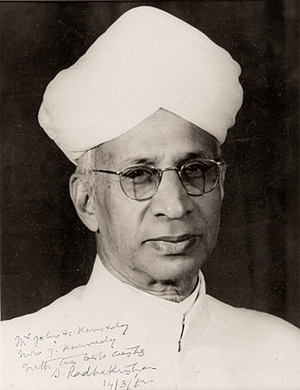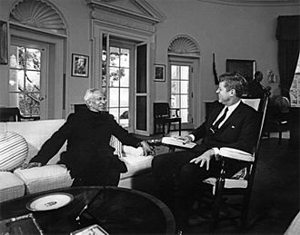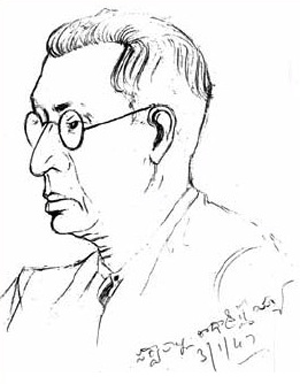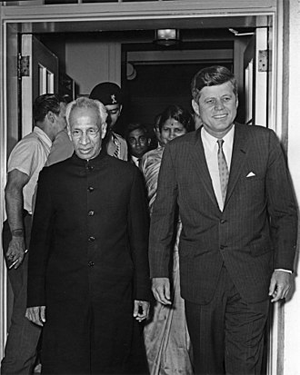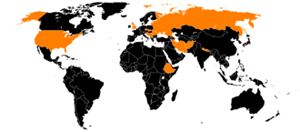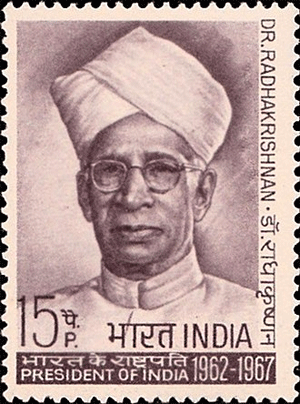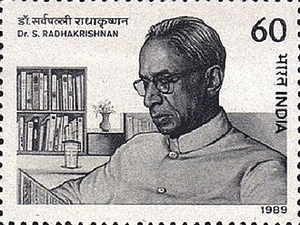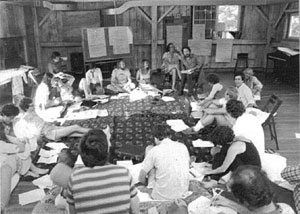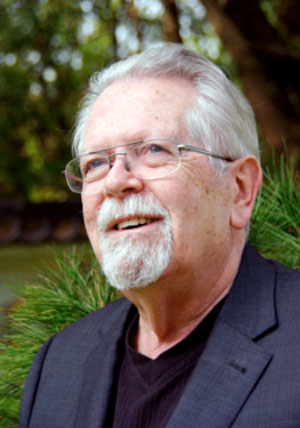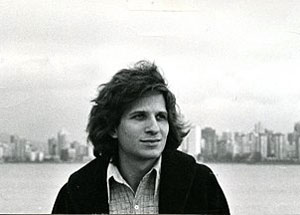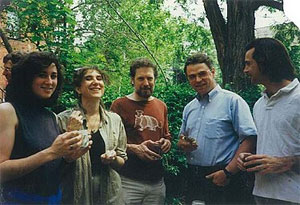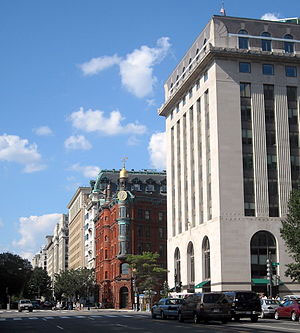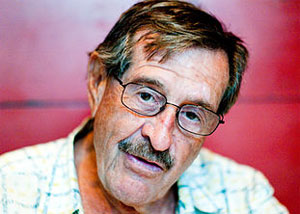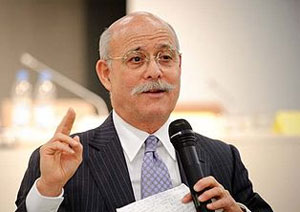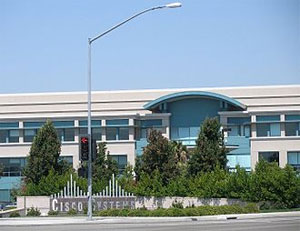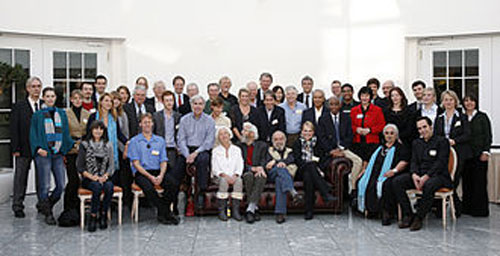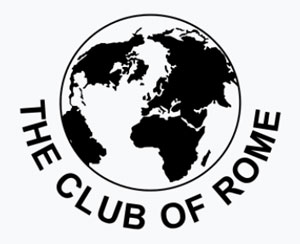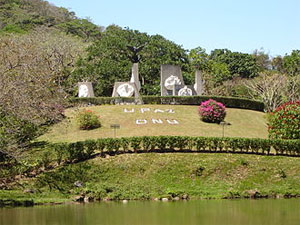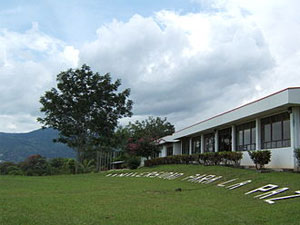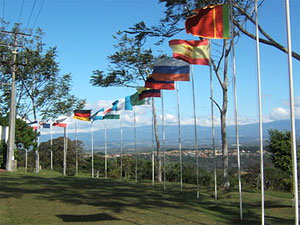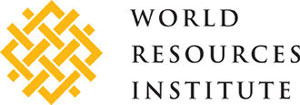by Donald F. Keys, speechwriter for United Nations Secretary General, U Thant
Printed and distributed by the Aquarian Age Community [Lucis Trust]
1970s
NOTICE: THIS WORK MAY BE PROTECTED BY COPYRIGHT
YOU ARE REQUIRED TO READ THE COPYRIGHT NOTICE AT THIS LINK BEFORE YOU READ THE FOLLOWING WORK, THAT IS AVAILABLE SOLELY FOR PRIVATE STUDY, SCHOLARSHIP OR RESEARCH PURSUANT TO 17 U.S.C. SECTION 107 AND 108. IN THE EVENT THAT THE LIBRARY DETERMINES THAT UNLAWFUL COPYING OF THIS WORK HAS OCCURRED, THE LIBRARY HAS THE RIGHT TO BLOCK THE I.P. ADDRESS AT WHICH THE UNLAWFUL COPYING APPEARED TO HAVE OCCURRED. THANK YOU FOR RESPECTING THE RIGHTS OF COPYRIGHT OWNERS.
Such grandeur is ahead!
Such a great step awaits its fiery affirmation!
Our teaching and the affirmation of the Higher Principles
will reveal so much that is great to humanity!
A great period is drawing near. Thus do we create together.
-- Fiery World, Vol. III, par. 149
Recognizing the interrelated oneness of humanity, and indeed of all life, the Aquarian Age Community is a pledged point of synthesis, resonating to the Aquarian keynote, “Water of Life Am I Poured Forth for Thirsty Men.” Responding to the Aquarian energies of universality, synthesis and loving understanding, it recognizes the spiritual destiny of Humanity and the divine potential at the heart of every individual. In keeping with the resonance of the new age, the Aquarian Age Community is first and foremost a subjective community, seeking alignment and identification with all Spiritual Beings who inspire the evolution of life on planet Earth. All who strive to better understand the new spiritual energies pouring into our planet and integrate them into daily living are a recognized part of the community. As a not-for-profit educational community, it supports the restoration of the Spiritual Mysteries and the transformation of human consciousness.
The Ageless Wisdom tells us that we live in a time of unprecedented opportunity. The dawning of the greater and lesser cycles of Aquarius have been awaited by the Hierarchy of Light and Love—the Masters of the Wisdom, the Teachers of humanity—for untold millennia. It is a time when millions within our human family will have the opportunity to make a leap in consciousness, realize their spiritual potential and actively cooperate in the restoration of the Plan of Love and Light on our planet. That Plan includes the externalization of the Soul—the inner divine principle at the heart of all life, the product of the union between spirit and matter. When the Soul is freed or resurrected from the matter in which it is encased, then will we know without a doubt that all life is in fact interdependent, interconnected and whole. Then, will we truly understand and live by the spiritual values of liberty, fraternity and equality.
In support of that externalization process, the Aquarian Age Community:
• Cooperates and collaborates with the worldwide community that is actively preparing the way for the reappearance of the World Teacher—the Christed (Anointed) One, the true Aquarian.
• Cooperatively participates in the unveiling of the Spiritual Mysteries.
• Promotes the evolution of human consciousness by advocating such new age sciences as the science of meditation, the science of the Antahkarana—bridging consciousness, and the science of service.
• Encourages the activation and mobilization of the will-to-good as it sounds the Aquarian keynotes of JOY and RESURRECTION.
• Promotes the work of the United Nations as it seeks to uplift and improve all life on our planet.
The Aquarian Age Community is dedicated in loving service to humanity, the planet and the “Great Thinker.” It is inspired by the teachings of Master Koot Hoomi, Master Morya, and Master Djwhal Khul as these are set forth in the books of Helena Blavatsky, Alice Bailey and the Agni Yoga Society. These teachings seek to inspire and prepare human consciousness for the great opportunities and possibilities of the 21st century.Belief in the Soul has become widespread during the last two thousand years.
Knowledge of the Soul is the promise of the Aquarian Age.
-- About the Aquarian Age Community, by The Aquarian Age Community
It is a challenge to discuss Spirituality at the United Nations. It is a challenge because most people will think that the UN is the antithesis of spirituality. I must report, however, that I regard the United Nations as the most spiritual place in the world today. The UN is the first planetary focus at the human level. It is the first place that the nerve endings of all humanity join. It is the first place where all the qualities, characteristics, attributes, and essences of all human groups merge and blend. It is truly, the first temple of humanity.
Of all the contention, of all the disputes, of all the struggles, I am fully aware -- much more so than bystanders, since I am in the middle of them on a nearly daily basis. That is, of course, one level of reality -- but it is not the most important one. We are on the verge of the meta-organization of the world -- by that I mean the reorganization of the world on a level higher than that of the participating nation-states. We have been stumbling toward this development for half a century, and of course it is only commencing -- it is not complete. We have also been moving toward it since the first day a human was born on earth, or perhaps since the earth itself was formed, 4 billion years ago.
A single species, the human, has indeed gained dominion over the earth, and having collapsed time and space, in communication and travel, to the speeds of sound and light, the humans have become a continuous and globe-uniting species. In this setting, the nation-state is dysfunctional, and states are facing incorporation into a world being, of which they will be subsidiary organs. When such a meta-organization occurs, there must be an organizing center, there must be an organizing energy, a synthesizing energy never before registered by the parts, and evoked by the coming emergence of the whole. This is true of the alignment of atoms into crystals, of cells into tissues, or of organs into a human form, and it is true of the subordinate elements of a society. Now we face the next evolutionary imperative. We are forming the world society.
The synthesizing energy for the world society is focussed through the United Nations. It courses through the halls, through the meeting rooms, through the offices of the United Nations. Blessed are those who are fortunate enough to work there for they are in touch with a new reality in the process of descent and manifestation. Hundreds of thousands of applicants are turned away each year from those who want to work there -- why? Basically, because they have heard the sound of humanity becoming whole and because they have sensed the new reality and have touched something of the energy of human convergence.
It is wearying, it is disappointing, it is tiring, but it is also thrilling, rewarding, and meaningful. The UN has its free loaders, its empire builders, its easy riders, and its CIA and KGB representatives, but it also has dedicated and inspired builders of the new world, spinning the future out of their own spirit, out of their own souls.
We have an informal network at the UN, a humanity underground. It consists of those who are committed, aware, and striving to bring the New World to birth. It consists of people in high places and in low -- of the patient secretary who has been 30 years with the UN, but lives with the vision and the spirit; of the professionals, and undersecretaries and heads of departments who are acting out the imperatives that their own inner vision gives them. Some few are conscious of the sources of their inspiration; most are not. They are the Karma Yogis of our time -- those whose path of spirituality is to achieve through doing -- to grow through serving. They are found not only in the secretariat but also in the delegations to the UN, among the diplomats and their staffs, and also among folks like us, representatives of non-governmental organizations around the UN.
I want however, in my remarks today to focus on the three major spiritual figures related to the UN, and an artifact. Two of the figures were Secretaries-General. The third is a non-governmental person.
The best known of the three persons is of course, Dag Hammarskjöld. The degree of the intensity of his inner life became apparent publicly after publication of his spiritual diary, Markings, following his death when his plane crashed in the Congo. In his briefcase, at the site of the crash, incidentally were found an English edition of the New Testament and Psalms which was always with him when he traveled, and a copy of Martin Buber's I and Thou, which he was translating into Swedish. Buber was a person with whom he felt a deep relationship.
With Hammarskjöld's temporal achievements we will not deal, except to say that he stabilized the United Nations, solidified the notion of an international civil service and independent Secretary-General -- free of political pressures, and originated the modern concept of UN peacekeeping. His personal credo was stated on Edward R. Murrow's program, "This I Believe:"
"The world in which I grew up was dominated by principles and ideals of a time far from ours and as it may seem, far removed from the problems facing a man in the middle of the twentieth century. However, my way has not meant a departure from those ideals. On the contrary. I have been led to an understanding of their validity also for our world today. Thus, a never abandoned effort, frankly and squarely to build up a personal belief in the light of experience and honest thinking has led me in a circle; I now recognize and endorse, unreservedly, those very beliefs which once were handed down to me.
From generations of soldiers and government officials on my father's side, I inherited a belief that no life was more satisfactory, than one of selfless service to your country or humanity. This service required a sacrifice of all personal interests, but likewise, the courage to stand up unflinchingly for your convictions.
From scholars and clergymen on my mother's side, I inherited a belief that, in the very radical sense of the Gospels, all men were equals as children of God, and should be met and treated by us as our masters in God.
Faith is a state of the mind and the soul. In this sense we can understand the words of the Spanish mystic, St. John of the Cross: 'Faith is the union of God with the soul'. The language of religion is a set of formulas which register a basic spiritual experience. It must not be regarded as describing in terms to be defined by philosophy, the reality which is accessible to our senses and which we can analyze with the tools of logic. I was late in understanding what this meant. When I finally reached that point, the beliefs in which I was brought up and which, in fact, had given my life direction, even while my intellect still challenged their validity, were recognized by me, as mine in their own right and by my free choice. I feel that I can endorse those convictions without any compromise, with the demands of that intellectual honesty, which is very key to the maturity of mind.
The two ideals which dominated my childhood world, met me, fully harmonized and adjusted to the demands of our world of today, in the ethics of Albert Schweitzer, where the ideal of service is supported by and supports the basic attitude to man set forth in the Gospels. In his work I also found a key for modern man, to the world of Gospels.Albert Schweitzer, (14 January 1875 – 4 September 1965) was a German and then French theologian, organist, philosopher, physician, and medical missionary. Early in his life he became acquainted with Annie Besant, who introduced him to Rudolf Steiner, who was still a member of the Theosophical Society (Adyar).[1]
-- Albert Schweitzer, by theosophy.wiki
***
Dear friend,
Much as I would like to, I cannot supply pieces that are not part of my normal program. That is why you have had to wait for my account of my experiences with Rudolf Steiner. Thank you for sending me all those writings about him. I have most of them in my library in Gunsbach, but it was easier getting them from you than having them sent to me from my library. The most valuable item was the autobiography. The reader really gets to know him. Too bad death took the pen from his hands.
I will write about our meeting in Strasbourg, where Annie Besant introduced us. I can still remember our conversations. They inspired me to keep dealing with him and to remain cognizant of his importance. What the two of us share is a desire to replace the uncivilized with civilization. In Strasbourg we both realized we had this rapport. He expected civilization to emerge from ethical thinking and from the insights of the humanities. In terms of my own character, I had to stick to having civilization come forth from an immersion in the true essence of the ethical. In this way I came to the ethics of the reverence for life which, I hope, will instigate the emergence of civilization.
I realize that Rudolf Steiner greatly regretted that I stuck to the old way of thinking, but we both felt the same obligation to lead people back to true civilization. I was delighted at what he managed to achieve in the world with his great personality and his profound humanity.
Everyone should follow the road that is his . . .
-- From Albert Schweitzer Letters 1905 – 1965, edited by Hans Walter Bähr, translated by Joachim Neugroschel (Macmillan Publishing Company, 866 Third Avenue, New York, NY 10022)In primarily Protestant German Europe, theologians who were acutely aware of the antagonism between Christian theology and modern scientific knowledge strayed from the Scriptures and their accessory libraries of commentaries and concordances, and instead sought novel perspectives through the study of contemporary philosophy, history, and even medicine. These historical and comparative methods were first developed into a school by the theological faculty of Tubingen University in the 1860s, and as historian Roy Pascal observes, "this historical research exerted perhaps a profounder influence on theology than the more sensational challenges of Darwinism." [26] These "theological modernists," as Pascal calls them, set out on a Promethean task to steal the fire of divinity from Christ and from Judeo-Christian traditions: "The heart of the Tubingen school was its biblical criticism, and its studies in comparative religion dispersed the solid revelations of Judaism and Christianity into a nebula of pagan sources." [27] During the Nazi era Tubingen became perhaps the dominant center for theology, for it was the base of operations for maverick Protestant theologian Wilhelm Hauer and his German Faith Movement. An English translation of two of Hauer's essays contains an introduction with a section entitled, "Tubingen -- The Home of the Neo-Pagan Movement." [28] Hauer was a close associate of Jung's in the early 1930s and participated with him in a seminar on Kundalini yoga in 1934.
The search for the historical Jesus proved to be the turning point for nineteenth-century critical theology and European culture as a whole, for by the end of the century, widespread skepticism about the divinity of Jesus and the truth of the stories in the Gospels of the New Testament opened the way for social experimentation with alternative religious, neopagan, occultist, or atheistic life-styles. These new paths of social action in European culture were, in part, the result of the intellectual climate created by the widely disseminated researches of German critical theologians. These ideas were denounced from the pulpits of many a Protestant minister (and many more Catholic priests) and were debated at both formal and informal events in the highly influential social worlds of the Protestant clergy. For some Protestant ministers -- such as, perhaps, Paul Jung -- the compelling new image of a historical Jesus led to a secret, shameful loss of faith in Jesus' divinity that had to be hidden from family and flock....
It was indeed in the Germanic lands of the Teutonic hero Siegfried and of the maturing parson's son C. G. Jung that the most serious challenge to Christianity fermented. Albert Schweitzer (1875-1965) is not shy about his openly Pietist exaltation of the German Volk and their contribution to the world in the introduction to his famous 1906 volume summarizing the research on the historical Jesus:
"When, at some future day, our period of civilization shall lie, closed and completed, before the eyes of later generations, German theology will stand out as a great, a unique phenomenon in the mental and spiritual life of our time. For nowhere save in the German temperament can there be found in the same perfection the living complex of conditions and factors -- of philosophic thought, critical acumen, historical insight, and religious feeling -- without which no deep theology is possible.
And the greatest achievement of German theology is the critical investigations of the life of Jesus. What it has accomplished here has laid down the conditions and determined the course of the religious thinking of the future." [30]
-- The Jung Cult: Origins of a Charismatic Movement, by Richard Noll
But the explanation of how a man should live a life of active social service in full harmony with himself as a member of the community of the spirit, I found in the writings of those great medieval mystics for whom "self surrender" had been the way to self realization, and who, in 'singleness of mind' and 'inwardness' had found the strength to say 'yes' to every demand, which the needs of their neighbors made them face, and to say 'yes' also, to every fate that life had in store for them, when they followed the call of duty, as they understood it. 'Love" that much misused and misinterpreted word, for them, meant simply an overflowing of strength with which they felt themselves filled when living in true self-oblivion. And this love found natural expressions in an unhesitant fulfillment of duty and in an unreserved acceptance of life, whatever it brought them personally of toil and suffering -- or of happiness.
I know their discoveries about the laws of inner life and of action have not lost their significance.
-- Dag Hammarskjöld
The diary, Markings, was translated into English by Leif Sjoberg and W.H. Auden. Of it Hammarskjöld had written: "These entries provide the only true profile that can be drawn. ...If you find them worth publishing you have my permission to do so, as a sort of 'white book' concerning my negotiations with myself -- and with God."
This extraordinary document is surely one of the most revealing and profound journals we have of the strivings of the human spirit. How to be fair to Secretary General Hammarskjöld in a few excerpts from Markings is a difficult task.
To love life and men as God loves them -- for the sake of
their infinite possibilities,
To wait like Him,
To judge like Him,
Without passing judgement,
To obey the order when it is given
And never look back-
Then He can use you- then, perhaps, He will use you.
And if He doesn't use you -- what matter. In His hand,
every moment has its meaning, its greatness, its glory, its
Peace, its co-inherence.
From this perspective, to "believe in God" is to believe
In yourself, as self-evident, as "illogical", and as impossible
to explain : if I can be, then God is
* * *
You are not the oil, you are not the air -- merely the point
of combustion, the flash point where the light is born.
You are merely the lens in the beam. You can only receive,
Give, and possess the light as a lens does.
If you seek yourself, "your rights," you prevent the oil and air
from meeting in the flame, you rob the lens of its transparency.
Sanctity -- either to be the Light, or to be self-effaced in
the Light, so that it may be born, self-effaced so that it may
be focussed or spread wider.
* * *
The United Nations Meditation Room:
"The Uncarved Block" -- remain at the Center, which is yours
and that of all humanity. For these goals which it gives to
your life do the utmost which, at each moment, is possible
for you. Also, act without thinking of the consequences, or
seeking anything for yourself.
* * *
The road,
You shall follow it.
The fun,
You shall forget it.
The cup,
You shall empty it.
The pain,
You shall conceal it.
The truth,
You shall be told it.
The end,
You shall endure it.
* * *
Tired
And lonely,
So tired
The heart aches.
Meltwater trickles
Down the rocks,
The fingers are numb,
The knees tremble.
It is now,
Now that you must not give in.
On the path of the others
Are resting places,
Places in the sun
Where they can meet.
But this
Is your path,
And it is now,
Now that you must not fail.
Weep
If you can,
Weep,
But do not complain.
The way chose you-
And you must be thankful.
* * *
Hammarskjöld -- second Secretary-General, aesthete, man of letters, poet -- was also a modern Christian mystic -- a candidate for human perfection and graduation from this life school. In one of Alice A. Bailey's books, written in the 1930's, there is a statement that a leading Swedish disciple would soon be working in the world. A high Swedish initiate who was a friend of mine was once asked if the foretold one were he. His answer was "no, it is Dag Hammarskjöld."
Let us now turn to the artifact -- for it was Hammarskjöld's artifact. I am referring to the UN Meditation Room. The existence of the room was a hard won battle, not by Hammarskjöld who came later, but by the "Laymen's Movement For A Christian World." This movement, led by such persons as Warren Austin, Weymen Huckabee, Mrs. Pearce Drake, Frank P. Graham, Frank Laubach and J.C. Penny, strove mightily to assure that there would be a place in the permanent UN for prayer and meditation. The same group had worked successfully to assure that there would be a moment of prayer at the beginning and closing of each General Assembly, a tradition which is now well established.
"It will take an Archangel to find space for a prayer room in this building," one UN official told Mr. Huckabee, as construction was well along and no one had entertained the notion in the original plans. One was eventually promised but where to put it was a question. The approach to prayer by the Laymen's Movement was described by Mr. Huckabee as follows:
We were asking people to use prayer as a means of understanding and goodwill -- a substitute for criticism and fault finding, an expression of hope and confidence in world leaders ---a means of expanding the atmosphere of expectation based upon the assumption that peace with justice is God's Will. With the promise of the room I saw a canopy of goodwill and understanding being raised over the UN by the prayers of men and women of all faiths.
By the time the meditation room was finally realized, Mr. Huckabee was able to say:
My mission has been fulfilled. I had a wonderful experience. I had seen in a small way how God can and does use people to bring something about. I knew we had not begun to use or to be used by this great unlimited power which God desires to release through men -- men who remember to pray, to love, to understand, to forgive. I knew that Peace IS the will of God and I wanted to know how now to make it the will of man.
The room was opened on October 14, 1952. From then until 1957 it was a comfortable, reassuring place with arm chairs, member nations' flags, draperies, carpeting and as a non-denominational center-piece, a section of an African mahogany tree. On top of the section, a small potted philodendron grew, symbolizing perhaps, everlasting life.
In 1956, a cosmic north wind, named Hammarskjöld swept in and, gaining the stunned and somewhat uneasy cooperation of the Laymen's Movement, undertook the complete redesign of the meditation room. In November 1957 the transformed meditation room was finally reopened. And what a change! The room in dim light is an austere trapezoid, narrowing to a front wall covered by a fresco titled "Infinity" by Hammarskjöld's favorite artist, Bo Beskow. Ten cane-seated benches are arranged in the back.
In the place of dominance in the room is something wholly surprising -- a six and a half ton triangular block of crystalline iron ore from a Swedish mine. The polished top is lit by a single beam of light from a source hidden in the ceiling. It glistens like moonlight in water. Approximately 60 slabs were mined before this one was chosen.
Let us now turn to Hammarskjöld's own remarks about this room:
The Meditation Room is a kind of stepchild of the architects of this house; it was brought into being as an experiment, but now I am happy to confirm that it is a permanent part of the building and I am sure it will be of increasing importance. We had a very small space within which we sought to achieve a room of stillness. This house must have one room, one place, which is dedicated to Silence, dedicated to silence in the outer sense and stillness in the inner sense. We must do everything possible in creating such a room to create an atmosphere where people could really withdraw into themselves and feel the void.
We had one difficulty, that in a room of this kind in a house of this character we could not use any kind of symbols with which man has been used to link his religious feelings; we had to work on the basis of symbols common to all. In a sense, what I think we had at the back of our minds was something which is said, I believe, in one of Buddha's scripts -- that the significance of the vessel is not the shell but the void. The significance of a room is not the walls but is in what is framed by the walls; that is to say, we had to create a room of stillness with perhaps one or two very simple symbols, light and light striking on stone. It is for that reason that in the center of the Room there is this block of iron ore, glimmering like ice in a shaft of light from above. That is the only symbol in the Room -- a meeting of the light of the sky and the earth.
However, in a certain sense the symbolism goes one step further. I do not know whether there is anything quite like the arrangement of that Room with a big block of stone in the center. The original idea was one which I think you will all recognize; you will find it in many great religions; it is the empty altar, empty not because there is no God, but empty because God is worshipped in so many forms. The stone in the center is the altar to the God of all. At the same time, at least to myself it had strong associations with the cornerstone, the firm element in a world of movement and turmoil. In this house, with its dynamic modern architecture, there are very few things that give you the feeling of weight, solidity and permanence; in this case we wanted this massive altar to give the impression of something more than temporary.
We also had another idea which comes down to what, after all, we are trying to do here in this house -- we are trying to turn swords into ploughshares; and we thought we could bless by our thoughts the very material out of which arms are made. For that reason we felt that it was appropriate that the material to represent the earth on which we stand, as seen by the light of the sky, should be iron ore, the material out of which swords have been made and out of which homes are built. It is a material, which represents the very paradox of human life; the basic materials offered by God to us may be used either for construction or destruction. This leads our thoughts to the necessity of choice between the two alternatives.
You see therefore, that in the seeming void of the Room there is something we want to say. We want to bring back the stillness, which we have lost in our streets and in our conference rooms, and to bring it back in a setting in which no noise would impinge upon our imagination. In that setting we want to bring back our thoughts to elementary facts, the facts we are always facing, life struck by light while resting on the ground. We want to bring back the idea of worship, devotion to something which is greater and higher than we are ourselves. We want to do that by the form of our altar in such a way as to bring to everybody's mind the fact that every single one of us is faced, in his handling of the heritage of the riches of this earth, with the choice between the ploughshare and the sword.
I want to say just a few more words about the Meditation Room. It both gains and suffers from its position. It is one of the holiest of holies of the planet, yet it is easily accessible by the public, being located in the Visitor's Lobby. It is thus, a great open secret. Anyone can go there at any time. It suffers in that delegates do not use it much precisely because of its location.
But I have to say that in some way, its talismanic quality performs quite irrespective of who uses or does not use it. When I say it is a holy of holies, I mean that it is a focus for the energies of a unitary planet, for a unified humanity, and for right relations between all the kingdoms of life. Those energies use the room and the stone like a lens; and through that spot they course through the meeting rooms, through the secretariat, through the delegations and by that route throughout the world.
Let me share one anecdote. Recently I had the pleasure of guiding a representative of the traditional wisdom of the Hopi People through the UN, including the Meditation Room. He was not expecting anything in particular. But when he entered the room, he audibly gasped. Quickly and apologetically, he reached for his medicine bag, took out a leather pouch from which he made an offering on the spot in front of the rock while saying prayers.
"We have been told," he said, "that there are three most powerful places in the United States. This is one of them, and I am going home to report it to the Elders." Which he then did.
Also, a dynamite bomb was placed in the Meditation Room. The fuse went out.
U Thant was the third UN Secretary-General. This gentle Burmese Buddhist was regarded as unremarkable, which was exactly what most major powers, particularly the USSR, wanted after the lightening bolt of Dag Hammarskjöld. It is increasingly difficult to be elected Secretary-General. States would generally prefer a good housekeeper who does not initiate, innovate or otherwise threaten their equilibrium or the status quo. But, U Thant's self effacing nature belied his moral courage and inner strength. Those who voted for him were later to find themselves very surprised. He was never really understood by the West and probably not by the communist states either. He was, however, universally trusted -- with confidences and in his word and fairness.
I knew the man personally, and loved him. I had the pleasure of sitting with him in his home, working on statements and articles, which would become history. I sensed the reverential atmosphere filled with Buddhic qualities, and knew that this son of the East was dearly beloved of the guides and mentors of the human race. U Thant was an earnest Buddhist and meditated at home every morning before driving to the UN.
The two fullest statements of U Thant's belief's and practices are contained in his talk on "The Role of Religious Convictions" at the Third International Teach-In at Toronto in 1967, and his personal statement in his memoirs, View from the UN (Doubleday, 1978, pp. 20-25, 453-454). Dead from cancer upon its completion, he was unable to continue to his second volume, which was to have been much more introspective than the memoirs devoted to his role at the UN.
He states:
As a Buddhist, I was trained to be tolerant of everything except intolerance. I was brought up not only to develop the spirit of tolerance but also to cherish moral and spiritual qualities, especially modesty, humility, compassion and most important, to attain a certain degree of emotional equilibrium. I was taught to control my emotions through a process of concentration and meditation. Of course, being human, and not yet having reached the stage of arhat (enlightened being) I cannot completely "control" my emotions ....
Among the teachings of the Buddha are four features of meditation, the primary purpose of which is the attainment of moral and spiritual excellence: meta (goodwill or kindness); karuna (compassion); mudita (sympathetic joy); and upekka (equanimity or equilibrium).
A true Buddhist practices his metta (kindness) to all, without distinction -- 'just as the sun shines on all, or the rain falls on all, without distinction. 'Metta embraces all beings impartially and spontaneously, expecting nothing in return, not even appreciation. Metta is impersonal love or goodwill, the opposite of sensuous caring or a burning sensual fire that can turn into wrath, hatred, or revenge when not requited....
Karuna ... the quality of compassion, is deeply rooted in the Buddhist concept of suffering. Human life is one of suffering; hence, it is the duty of a good Buddhist to mitigate the sufferings of others.
Mudita (sympathetic joy) can best be defined as one's expression of sympathy with other people's joy. The happiness of others generates happiness in the mind of a good Buddhist .... The person who cultivates altruistic joy radiates it over everyone in his surroundings....
Upekka (equanimity) connotes the acquisition of a balance of mind whether in triumph or tragedy. This balance is achieved only as a result of deep insight into the nature of things, and primarily by contemplation and meditation. If one understands how unstable and impermanent all worldly conditions are, one learns to bear lightly the greatest misfortune or the greatest reward. To achieve upekka, one has to meditate....Buddhist meditation aims at cleansing the mind of impurities, such as ill will, hatred and restlessness; it aims at cultivating such qualities as concentration, awareness, intelligence, confidence, and tranquility, leading finally to the attainment of the highest wisdom....
U Thant also writes that he was greatly influenced by the writings of Albert Schweitzer and his concept of "reverence for life," and by those of Pierre Teilhard de Chardin. In stating his own concept of human society, he states:
I am always conscious of the fact that I am a member of the human race.... This consciousness prompts me to work for a great human synthesis, which is the implicit goal of the world Organization I had the privilege of serving.... Long before I was appointed Secretary-General, I used to dwell at some length on the oneness of the human community.
Indeed, as a result of these convictions, U Thant became a founding co-Chairman of Planetary Citizens, which, together with Norman Cousins, we originated. In the closing pages of his memoirs U Thant again called for "a new concept of citizenship."
I am making a plea, he said, based on these ten years of looking at the human condition from my unique vantage point-for a dual allegiance. This implies an open acceptance of belonging... to the human race as well as to our local community or nation.... I believe that the mark of the truly educated person facing the 21st century is that he feels himself to be a planetary citizen.
The third figure I wish to discuss in the context of spirituality at the UN is not a Secretary-General, nor an official of any kind. He has, however, led meditations twice a week at the UN for 10 years, nearly one third of the life of the Organization. Sri Chinmoy comes from the lineage of saints and sages of the East, in the line of and in the tradition of Ramakrishna and Aurobindo. Like them, he is a post-graduate human. In his case, he awoke to that fact when in his early teens, and spent the next 20 years perfecting his inner tools for his life at the ashram of Aurobindo in Pondicherry, India.
It is not surprising to me that such an exalted being would choose - or be asked from within, to assume responsibility for spirituality at the UN as part of his mission. Rather it would seem inevitable, because of what he is, and of what the UN represents and strives to become. If there is any place on earth which is appropriate to an Avataric being, and where he is needed, surely it is the fledgling world organization, struggling to unify humanity and carry it to the next level of awareness. Thus we find Chinmoy acting as invoker and intermediary for the vastest and most significant energies the world has yet received, with our meditation group of 60 or 70 people striving to serve as a lens and distributing agent for the light, love, and purpose he brings down into our midst.
We are attempting to bring together and assist in publication of the statements he has made at these meditations about the UN and its task, and about the world community, and I would like to share with you some excerpts from this increasingly significant material. Of course, he recognizes the soul of the UN as well as its present outer manifestation. He recognizes the future of the world organization as well as its present state. He offers solace and comfort, he brings inspiration and insight, and he generates enthusiasm and expectancy for an unfolding reality.
A spiritual Goal for the United Nations; Is it practical?
Without the least possible hesitation I venture to say that it is highly practical. It is not only practical, but also practicable. Something more: it is inevitable. We have to know what the spiritual goal for the United Nations is. Its Goal is to become ultimately the saviour of the world's imperfection, the liberator of the world's destruction and the fulfiller of the world's aspiration.
My heart tells me that the United Nations has a divine Ideal. My soul tells me that this Ideal is going to be transferred into the supreme Reality. Soulful concern is the essence of the United Nations' Ideal. Fruitful patience is the substance of the United Nations' ideal. Supernal fulfillment will be the essence of the United Nations' Reality.
Today's United Nations offers hopeful and soulful advice to mankind. Tomorrow's United Nations' will offer fruitful and fulfilling peace to mankind. Today's United Nations' feels truth, Light and Delight in its loving heart. Tomorrow's United Nations' will manifest Truth, Light and Delight with its all-embracing soul.
My aspiring heart has a soulful message to offer to all the nations that have formed, that have made the Garland of the United Nations. The message is this:There are two stumbling blocks: doubt and insecurity, Doubt in the mind, insecurity in the heart. There [are] two stepping stones: faith and surrender. Faith in oneself and surrender to God's will, conscious surrender to God's constant Will...
The message that the soul of the United Nations offers to the world at large is for Eternity. Its message is that today's imperfect and unfulfilled man is tomorrow's absolutely fulfilled and supremely manifested God. (Garland of the Nation Souls pp 27-28-29)
On another occasion Sri Chinmoy stated:
Needless to say, the world is still not perfect. Since the world is not perfect, the world opinion cannot be perfect.... There are many on earth who find fault with the activities and the dedicated services of the United Nations. But from the spiritual point of view, I wish to say that each action and each dedicated service is not a mere experiment, but an experience of God in and through the United Nations. ....This is what we see and feel in the heart of the United Nations.
From the spiritual point of view, the United Nations is struggling and striving for something meaningful and fruitful. What it needs, it has; Divine Compassion. The Compassion of God has been unceasingly descending upon the United Nations.
It is not in vain or without any purpose that the United Nations has come into existence. God's vision has to be manifested here on earth. The suffering nations need a place for consolation; the sacrificing nations need a place for appreciation. Here in the United Nations we see the message of fulfillment. Now it is up to the world. The world, the sleeping, unaspiring, unawakened world is not yet receiving the Light of the United Nations. There are many things that the world could get from the dedication of the United Nations: but if the world is not receptive, it is not the fault of the United Nations.
God is all Compassion, He is all giving; but if we don't want to receive His Light the way He wants to offer it, that is not His fault. The heart of this place is dedication, the soul of this place is concern, the body of this place is for the illumining expansion of human consciousness.
... When we go deep within, we see that a seed was sown here in the earth-consciousness and that seed has boundless potentiality. God's Light is here for humanity to receive on a practical level, in an earthly manner. God's Light is here to illumine us. Consciously and unconsciously the world is receiving this Light from the United Nations; but the United Nations is not being recognized, and this fact is deplorable. The human beings who have become instruments to offer the Light that the soul of the United Nations has, may not be fully aware of what they are doing. When they see the imperfections in others, when they see their limited capacity, at times they feel frustrated. But the Divine in each individual nation is all-wise. It has chosen the right place and the right instrument -- the United Nations.
... The United Nations is the chosen instrument of God. To be a chosen instrument of God means to be a divine messenger carrying the banner of God's inner vision and outer manifestation. One day the world will not only treasure and cherish the soul of the United Nations but also claim the soul of the United Nations as its very own with enormous pride, for this soul is all-loving, all-nourishing, and all fulfilling. (Garland, pp 66-68).
In speaking to the meditation group, Sri Chinmoy once said:
We are the most fortunate people on earth, for God has chosen us to be his instruments to serve Him in mankind. Please try to feel that the United Nations is not a mere building, but a place of worship, a place where all human beings can worship and pray to God. This place is a living shrine for the Supreme.
On another occasion he said:
This meditation is not only for the United Nations but also for the world at large. If we really love God, and if we really love mankind and consciously believe that we are responsible for mankind, then we feel that our aspiration and dedication to the soul of the United Nations and our inner pilot is of paramount importance. Please feel that it is your own aspiration that will expedite the vision for the United Nations. And when the vision is transformed into reality, the inner pilot will know our contribution whether or not the world ever recognizes it....
Sri Chinmoy had a particularly poignant and deep relationship with U Thant. I attended a performance of plays on the life of the Buddha by Chinmoy that were dedicated to U Thant and performed for him. Of U Thant at his passing, Chinmoy said:
U Thant was a chosen instrument of God. U Thant was a chosen instrument of man. God gave him Compassion-sky to offer to man. Man gave him his suffering-sea to offer to God. Earth gave him the responsibility. Heaven knew and saw it. Heaven gave him the authority, but unfortunately earth did not know it or did not care to know it. His heart of brotherhood was misunderstood. His life of sacrifice was not valued. But his vision and goal of oneness will eternally be pursued by aspiring humanity.
Is Sri Chinmoy properly appreciated by the United Nations? Not entirely. Both the present Secretary-General, Javier Perez de Cuellar, and the past Secretaries-General, Kurt Waldheim and U Thant, have appreciated his work and that of the UN Meditation Group. Selected delegates and many secretariat staff as well as some NGO representatives do. However, such overt spirituality is still a big step for many.
Spirituality at the United Nations? The UN is a place of contrast and contests. It is a place of contrast between selfishness and sharing. It is a place of contests between the narrow self-interest and the world community's good. It is the major battle line for the future of humanity's soul and collective well being. It is the locus for the emergence of higher values concerning humanity as a whole, and the rebirth of the race as a Planetary Entity, a Planetary Human Being. Therefore, from the inner side the wiring has been put in place, the energies of emergence are focused, the power for planetary transformation is available. It is even represented there by a conscious post-human intermediary of great power. It is too early yet to tell whether that promise will be recognised, accepted by humanity and acted upon or scorned. But rest assured that those of us who work there with the vision before us will continue to worship at the altar of humanity-become- whole, for you and for all.
1 Written in the early 1970s by Mr. Donald Keys, when he was a speechwriter for Secretary-General, U Thant and Founder/President of Planetary Citizens. Printed and distributed by the Aquarian Age Community with the kind permission of Mr. Keys.

